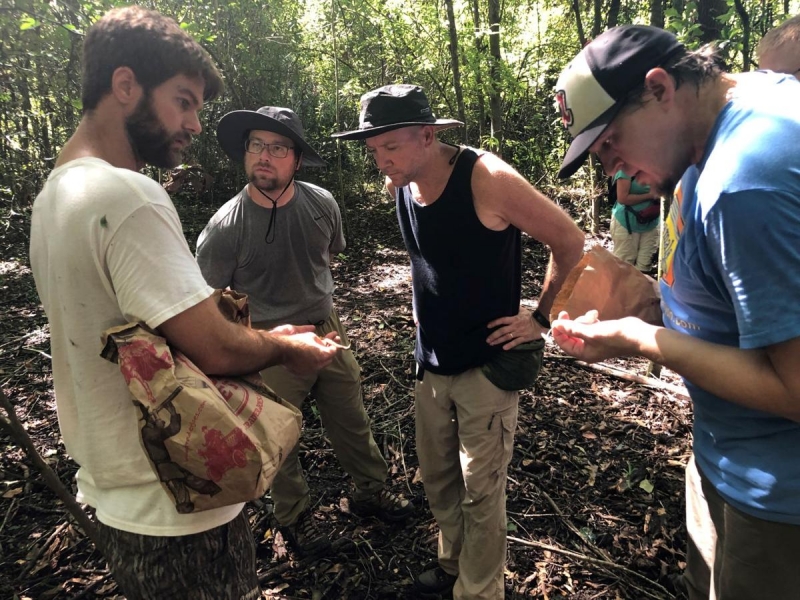
The importance of fungi should not be underestimated. Some are quite delicious.
So found out a group who took a "mycological foray," better known as a mushroom hike, on a muggy Saturday morning into a bottomland hardwood forest in central Louisiana.
Mushroom aficionado Logan Wiedenfeld led the group of intrepid gathers, all members of Louisiana Master Naturalists of Greater Baton Rouge.
“I’m reluctant to use the term obsession," said Wiedenfeld, an English professor, "but studying mushroom taxonomy is an important part of my life.”
Wiedenfeld said the South is a source of many varieties of mushrooms that are plentiful and delicious. Because of the climate, Louisiana is good for mushroom hunting almost year-round.
“The best seasons are late spring, early summer and early fall,” Wiedenfeld said, adding that any forest floor will do as will your own backyard.
So, coated in bug spray and sunscreen, the group trekked through the trees, clutching brown paper bags to collect their bounty.
In Louisiana, boletes, oyster mushrooms, chanterelles and morel mushrooms are all common in the wild and prized for their flavor.
Especially tasty are chanterelle mushrooms, usually found near water oaks. Colored deep gold to orange, the taste is described as peppery with apricot nuances. It is delicious, some say, when prepared with garlic, cream or butter.
But not every mushroom in the wild is edible. Toxic mushrooms are also out there, Wiedenfeld cautioned, and some, most notably the "destroying angel" taxa, can be lethal if swallowed.
“Like a lot of hobbies, this takes time to learn and study. This isn’t something you can master overnight," he said. "Before you choose to eat a new species, be sure — first — that you have a good ID.”
Bonnie D’Antonio was leery to eat anything she gathered unless an expert deemed it safe.
“Better to just leave it alone and admire from afar,” she said.
Wiedenfeld said that as a kid, he grew up foraging for berries in the woods with his dad but doesn't recall seeing mushrooms.
"I’m sure they were there," he said, "and we walked over many in the woods. I just never paid attention."
Now, his eyes scan decaying logs and specific trees looking for fungal treasure.
“Mushrooms are a crucial part of forest ecosystems, either symbiotic in helping their host plants or helping to decay rotten material in the forest,” Wiedenfeld said.
He said he is always discovering new ones, even in his own Baton Rouge yard, where he has found four previously unknown species of mushrooms. Mycologists formally named one of them “amanita batonrougensis.”
On this hunt, the local group harvested dozens of chanterelle mushrooms, and all were dubbed safe to eat. If purchased, Wiedenfeld told them, they could cost as much as $15 per pound because chanterelles, which cannot be grown commercially, must be picked by hand.
The group also discovered about 50 species Wiedenfeld couldn't identify, so he gingerly packed them up for further study.
Wiedenfeld also reassured the naturalists that harvesting the mushrooms does not cause any harm to the organism.
“The mushroom is to the mycelium what the apple is to the tree,” he explained.
Before heading out for your own mushroom-hunting trip, investigate regulations depending on where you plan to go.
Louisiana Wildlife Management Areas require a hunting license or a Wild Louisiana Stamp, for ages 16 to 60, which costs about $10. This allows you to collect up to 5 gallons per person per day. Be sure to check in at each WMA and be wary during hunting seasons.
LMGBR President John Nettles said future forays are planned, and the Master Naturalists group hopes to offer a class for the public soon.
One upcoming mushroom field walk is in Picayune, Mississippi, at 10 a.m. Sept. 7 at the Crosby Arboretum, 370 Ridge Road. Call (601) 799-2311 for reservations. Bring your own knife, gloves and basket or bag for collecting. The cost is $5.
For more information about mushrooms, check out “Mushrooms of the Gulf Coast States: A Field Guide to Texas, Louisiana, Mississippi, Alabama, and Florida” by Alan E. Bessette, Arleen R. Bessette, and David P. Lewis; mushroomobserver.org; mushroomexpert.com and The Gulf States Mycological Society at gsmyco.org.
























